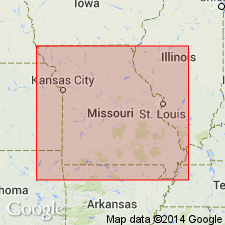
- Usage in publication:
-
- Stegall rhyolite
- Modifications:
-
- Principal reference
- Dominant lithology:
-
- Rhyolite
- AAPG geologic province:
-
- Midcontinent region
Summary:
Stegall rhyolite of Middlebrook group. A dark purplish-red rhyolite comprised of 2 or more flows; flow banding is prominent. Contains small, red potash feldspar and numerous small glassy quartz phenocrysts. Miarolitic cavities are numerous and elongated parallel to flow banding; usually partly filled with fluorite crystals, some are filled with epidote. Thickness at least 500 feet. Exposed on Stegall Mountain (type), Mule Mountain, and Thorny Mountain, in St. Francois Mountains, Shannon County, southeastern Missouri. Base not exposed; underlies tuffs of uncertain age. Age is Precambrian.
Type section: on northwest slope of Stegall Mountain, in sec. 19, T. 28 N., R. 2 W., Shannon Co., MO.
[GNU remark (Feb. 16, 1990, USGS DDS-6; Denver GNULEX): Stratigraphic relationships of units of Middlebrook not discussed in text; geologic map (plate 1) missing from library copy of report.]
Source: Modified from GNU records (USGS DDS-6; Denver GNULEX).
For more information, please contact Nancy Stamm, Geologic Names Committee Secretary.
Asterisk (*) indicates published by U.S. Geological Survey authors.
"No current usage" (†) implies that a name has been abandoned or has fallen into disuse. Former usage and, if known, replacement name given in parentheses ( ).
Slash (/) indicates name conflicts with nomenclatural guidelines (CSN, 1933; ACSN, 1961, 1970; NACSN, 1983, 2005, 2021). May be explained within brackets ([ ]).

